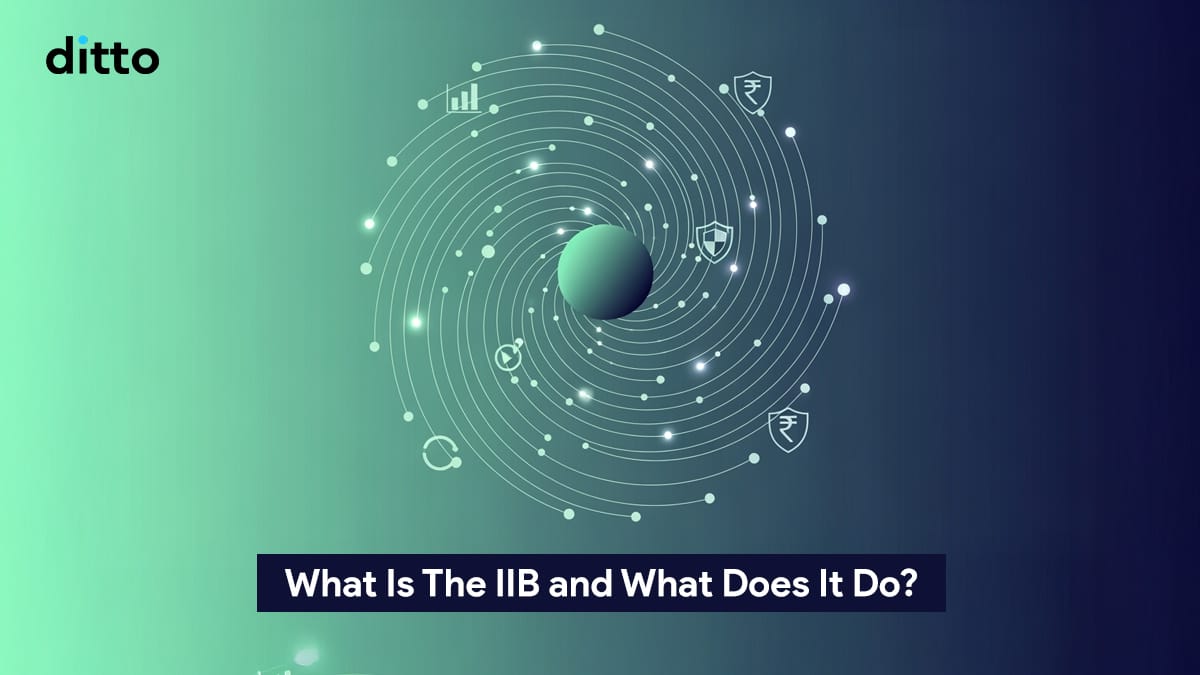| What Is the Insurance Information Bureau of India (IIB)? The Insurance Information Bureau of India (IIB) is an autonomous body established by the Insurance Regulatory and Development Authority of India (IRDAI) in 2009. It serves as a central repository for insurance-related data across life, health, motor, and other insurance segments. It aims to enhance transparency, promote data-driven decision-making, and support the development of the insurance sector in India. Its mission is to provide information support in a complete, consistent, and concise manner to all stakeholders associated with the Insurance Sector, including Insurers, Regulators, and Government Agencies. |
The Insurance Information Bureau of India (IIB) plays a vital role in shaping India's insurance ecosystem. It serves as a central hub for collecting and analyzing industry-wide data. By enhancing transparency and promoting accountability, the IIB has become a cornerstone of informed decision-making for insurers, regulators, and consumers alike.Similarly, at Ditto, we help our customers leverage our database, operations, and claims team experience to make informed insurance decisions.
This guide is presented to help you understand:
- The origin of the Insurance Information Bureau (IIB)
- Its core functions and key initiatives
- How IIB's data-driven insights support insurers and regulators
- The impact of IIB on consumer protection, innovation, and trust in India's insurance sector
If you have follow-up questions or you'd like to learn more about Insurance Information Bureau (IIB), book a free consultation with Ditto and our expert advisors will help you out.
Quick Overview:
IIB deals in four insurance sectors: Health, Life, Property and Motor.
Here’s certain milestones IIB achieved:
- No. of Queries made by Insurers so far – 1.45 crore
- No. of Policy Records in Database – 11 crores
- No. of Critical Matches (Potential Frauds) identified over QUEST – 10,675 (Sum Assured Rs. 6424 crores)
The affairs of IIB is managed by the Governing Council, consisting of a minimum of 9 members and a maximum of 21 members. Ajay Seth, the IRDAI chairman, currently serves as the IIB chairman, while Venkat Changavalli is the present CEO.
| If You Need Official Confirmation, you can reach IIB via their contact page: Email: support@iib.gov.in Address: Insurance Information Bureau of India, 1st floor, APSFC Building, 38/39, Financial District, Nanakaramguda, Telangana 500032 Note: Click here and Provide identification (vehicle number, policy details, etc.) for any verification request. |
What is the Origin of IIB?
The Insurance Information Bureau (IIB) was established to meet the increasing demand for accurate, consistent, and timely insurance data for various purposes. Before its establishment, information on underwriting, claims, premiums, and risk management was scattered across insurers and government agencies.
| Did You Know? IIB has developed the following portals for the insurance sector to be more organized, traceable, and compliant: 1) Envoy: The portal serves as a repository of licensed Insurance Sales Persons in the Indian Insurance sector, working independently and also under an intermediary. 2) Point of Sales: The Point of Sales Person can be an intermediary who markets all insurance products or an individual who solicits only pre-underwritten products approved by IRDAI. |
What Are the Core Functions of the IIB?
Services provided by IIB can be classified as Verification, Fraud tools & Fraud triggers and Predictive analysis. It performs several critical functions to support the insurance industry such as:
- Centralized Data Hub: Provides insurers with real-time, actionable insurance-related data, enabling them to identify duplicate or suspicious claims quickly. This ensures that genuine claims raised by policyholders are settled faster and with fewer disputes.
- Data Insights: With access to accurate data on risk patterns, claim frequency, and regional trends, insurers can price policies more precisely, offering fairer rates and better value to low-risk customers.
- Stronger Fraud Protection: The upcoming Insurance Fraud Monitoring Framework (2025), powered by IIB data, will require insurers to share real-time data by April 2026. This early detection system will help prevent fraud and protect both customers and companies.
- Greater Transparency and Market Insight: IIB’s analytical insights support IRDAI in monitoring market health, improving solvency oversight, and ensuring a stable, transparent, and consumer-friendly insurance ecosystem.
- Benchmarking & Reporting: Publishes industry benchmarks, such as mortality and morbidity studies under the Mortality and Morbidity Investigation Cell (MMIC), to guide product pricing and risk evaluation.
IIB publishes the following:
- Annual Reports: Summarize major trends and performance across insurance segments
- Thematic Reports: Offers in-depth insights into specific insurance areas to inform strategies and decisions.
- Customized Reports: Tailored, on-demand analyses designed to meet insurers’ specific data and business needs.
| Point to be noted: Though IIB helps reshape the Indian insurance sector, it has Limitations such as : 1) Not a claims portal: IIB doesn’t handle or resolve insurance claims; customers must contact their insurer directly. 2) Data delays possible:V-Seva (a system to check if a vehicle is insured, view accident records, or third party claims) relies on insurer submissions, which may result in some data being delayed or incomplete. 3) Cybersecurity concerns: Despite strict safeguards, the 2023 cyberattack highlighted data risks and led to tighter cybersecurity rules by IRDAI. 4) Privatization on hold: Plans to corporatize IIB (proposed in 2022) are still under review, with no final update as of 2025. |
Why the IIB Matters for You and the Industry ?
IIB plays a significant role in making the insurance sector more transparent, fair, and efficient. Here’s how it benefits the people involved:
- Empowering Consumers: While IIB's role is mainly behind the scenes, its impact has been significant. Maintaining clean and standardized insurance data has ensured fairer premium rates, faster claim settlements, and fewer disputes over claims. The only direct public tool currently available is V-Seva, which enables users to verify a vehicle's insurance status and basic accident history, particularly after road accidents or when purchasing used vehicles.
- Supporting Insurers: Insurers utilize IIB’s insights to enhance pricing, refine medical underwriting, mitigate risks, and develop more effective and affordable products that align with customer expectations.
- Guiding Regulators: Regulators, such as the IRDAI, rely on IIB’s data to create evidence-based policies, monitor compliance, and maintain a stable and competitive insurance market.
| Did you know? Registry of all Hospitals in the network of Insurance (Rohini), a health initiative by IIB, encompasses all hospitals in India that are part of the Health Insurance Provider Network. This is achieved through a unique ID for each hospital, which helps reduce fraudulent claims and makes health insurance more affordable in the long run. |
How IIB Data Has Shaped the Insurance Market?
The data provided by the IIB has led to significant improvements and advancements in the insurance sector:
- Digital Transformation: Insurers have leveraged IIB data to develop mobile apps that offer a seamless experience, from buying an insurance plan to filing a claim. IIB has enabled sector digitization primarily through industry utilities such as iTrex (the central index server that allows insurers to/repositories to exchange e-KYC and policy data) and QUEST (a shared life-insurer fraud/ND-mis-rep platform).
- Regulatory Reforms: Data on underwriting practices and loss ratios reported by the IIB have influenced the IRDAI's guidelines and decisions regarding reinsurance and risk management.
In short, IIB's robust data systems and predictive tools have transformed how India's insurance industry operates, forming the silent backbone of India's transition toward a data-driven, digital-first insurance ecosystem.
What are some of the IIB’s core products?
Let’s take a quick look at some of IIB’s core products and tools (FY 2023–24) from the IRDAI Annual Report 2023-24:
| Name of Product | Sector | Objective |
|---|---|---|
| Prism | Life | -Predictive life Risk Scoring Model, which helps identify potentially “bad” lives. - 4.23 crore queries have been made during the last four years. |
| Prowess | Life | Persistency Model, which helps to zero-in on the Proposals/Policies that are most vulnerable to dropping off prematurely |
| Bima Satark | Health | Real-time integrated fraud analytics platform that generates early warning system triggers through SATARK APIs to proactively flag suspicious entities |
| HI Portability | Health | -Health Insurance portability tool that enables exchange of applicant’s policy, member and ABILITY claims related information between port-in and port-out insurers -The platform resulted in 5 lac hits |
| Udayan | Motor | Real-time tool to gather vehicle details available via API and provides 25 vehicle related during underwriting and claim settlement process |
| iPRAN | Fire | Property Risk Analyzer which provides district-level risk profiles using 5-year underwriting and claims data, aids underwriters in fire-insurance risk selection. |
Why Talk to Ditto for Your Health Coverage?
At Ditto, we’ve assisted over 7,00,000 customers with choosing the right insurance policy. Why customers like Arun below love us:

✅No-Spam & No Salesmen
✅Rated 4.9/5 on Google Reviews by 5,000+ happy customers
✅Backed by Zerodha
✅100% Free Consultation
Key Takeaways
The Insurance Information Bureau of India(IIB) has brought around significant changes in the Insurance sector in India, promoting transparency and accountability. Here’s are some final thoughts:
- Supports Insurers: IIB's shared data helps detect fraud, reduce duplicate claims, and improve premium accuracy over time.
- Not a Claims Resolver: IIB does not handle policy errors. Contact your insurer to resolve any discrepancies.
- Data Updates: V-Seva reflects insurer submissions; minor delays or outdated info can occur.
- Security Reminder: At Ditto, we advise our customers to be cautious of phishing and never share OTPs or make payments through unofficial links for their insurance premiums.
Overall, the IIB strengthens the insurance ecosystem, enabling sustainable growth and consumer protection.
Still unsure how to go about purchasing a health policy? Book a call with us, and let our experts guide you through the process.
FAQs
What is the role of the Insurance Information Bureau of India (IIB)?
The IIB serves as a central repository for providing unbiased and accurate data analysis and critical insights to India's insurance sector.
How does the IIB support the insurance market?
By compiling and analyzing reliable and timely data from registered insurers, the IIB facilitates risk evaluation, policy-making, and market innovation.
How does the IIB contribute to consumer protection?
The IIB facilitates grievance redressal, claim settlement, and fraud detection, promoting customer protection and satisfaction.
How can I access my insurance data through the IIB?
IIB does not yet provide consumer-level access to life, health, or property policy data. These datasets are shared only among insurers, IRDAI, and authorized entities. As a policyholder, you must contact your insurer for any personal data, claim records, or policy details.
Can I find the number of complaints using IIB?
The IIB itself does not handle or publish individual complaint data. However, it provides data-driven insights and reports on areas such as claims, underwriting, fraud detection, and market trends.
Last updated on:







